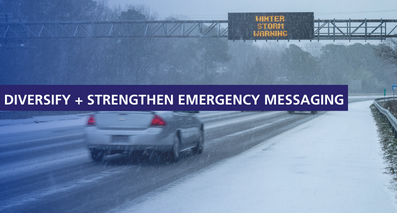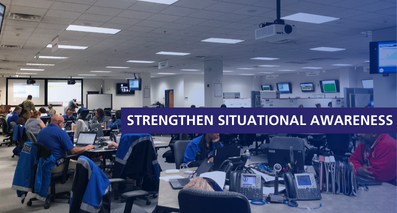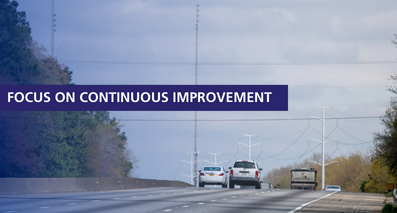After-Action Report
The January 3 snowstorm affected the entire Commonwealth of Virginia. What started as rain changed to heavy, wet snow, which fell at historic rates of up to 3 inches per hour. In the course of 24 hours, temperatures dropped more than 40 degrees.
The snowstorm iced roads, downed trees, disrupted services and impacted motorists on interstates throughout the Commonwealth, most severely Interstate 95.
In response to the hardship experienced by travelers on Virginia roadways, the Virginia Department of Transportation (VDOT), Virginia State Police (VSP) and Virginia Department of Emergency Management (VDEM) worked with CNA, an independent third party, to conduct a review of the commonwealth’s storm preparation and response. This after-action report lays out what the agencies did well and areas for improvement.
After-action reportCommitted to safety and improvement
VDOT is committed to the safety of the traveling public on Virginia roadways.
In response to the after-action report findings VDOT’s focused on the following:
-
Expand operational planning
-
Improve coordination
-
Diversify + strengthen emergency messaging
-
Strengthen situational awareness
-
Focus on continuous improvement
Frequently asked questions
Explore these topics.
Choose from the following topics to explore frequently asked questions about VDOT’s response to the Jan. 3 snowstorm and the after-action review.
Prior to every winter season, the Virginia Department of Transportation, along with its partners at the Virginia State Police and Virginia Department of Emergency Management, plans for winter storms and tests procedures, protocols and machinery.
Statewide teams convened Sunday, Jan. 2 to determine needs, staffing plans and response approach.
The Jan. 3 snowfall was preceded by hours of rain. The roads were unable to be pretreated because the rain would have washed the treatment off the roads.
Nearly 4,000 VDOT staff members and 16,800 contractors were positioned state-wide to respond to the storm.
On I-95, 47 plow trucks were staged and six wreckers patrolled the interstate. VDOT personnel and other response partners were on the ground throughout the incident, checking on motorists, directing vehicles off the interstate onto passable interstate ramps, and assisting tractor-trailer operators not accustomed to driving in snow and ice.
This storm included a unique blend of rain, historic snowfall rates and temperature shifts of over 40 degrees. Disabled tractor-trailers and passenger vehicles along with downed trees impeded motorist travel, VDOT personnel and other agency responders. Power outages impacted nearly 500,000 customers and disrupted VDOT’s 511 cameras and on-road overhead messaging.
VDOT had adequate staff and equipment to clear the roads for the snow accumulation, as forecasted. Still, additional variables including disabled vehicles, historic snow rates, downed trees and power lines impacted the typical service levels and timelines.
There must be other viable detours for motorists to close a major highway. On Monday, Jan. 3, there were no passable alternative routes. Upon treating detour routes of snow and downed trees and debris, I-95 was closed in both directions.
Roadways statewide were impacted by the storm, including significant interstates and commuter roadways like I-95, I-64, I-81, Route 1, Route 3 and Route 301. Interstate 95 had the most-severe traffic volume impacts, but there were multiple interstates with lanes blocked during this storm.
The after-action report is a post-event review of the Commonwealth's storm preparation, mobilization, processes, and response, analyzing performance and identifying lessons learned.
VDOT is committed to the safety of the traveling public and is steadfast in its commitment to be adaptable and agile in the service of Virginia motorists. Secretary of Transportation Shannon Valentine and Secretary of Public Safety and Homeland Security Brian Moran have requested the Virginia Department of Transportation, Virginia State Police and Virginia Department of Emergency Management to include a comprehensive timeline of events in the multi-agency after-action review.
CNA, an independent third-party firm, worked with VDOT, VSP and VDEM to conduct a thorough and comprehensive after-action review of the storm response. CNA has an existing contract with the Commonwealth of Virginia through VDEM. The task order associated with the review is $79,427.96.
VDOT is implementing new storm response tactics, including re-evaluating resource deployment, reassessing where and how many pieces of equipment and personnel are needed, assigning additional dedicated personnel to provide real-time updates about road conditions, improving public communications, implementing more direct and consistent on-road overhead messaging and enhancing coordination with emergency response partners.
Extreme weather events will continue to happen, and the agency is folding lessons learned from the Jan. 3 storm and every storm that follows to hone processes to ensure better procedures, equipment, materials and team can mitigate impacts to Virginia motorists in the future.













